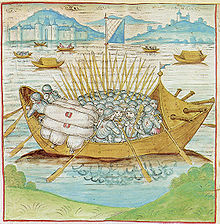Sea battle near Männedorf
| date | October 29, 1445 |
|---|---|
| place | Lake Zurich near Männedorf , Canton of Zurich |
| output | Zurich's victory |
| Parties to the conflict | |
|---|---|
|
|
|
| Commander | |
|
|
|
| Troop strength | |
| 12 ships | 20 ships |
| losses | |
|
unknown |
at least 16 men |
Etzel · Pfäffikon · Grüningen I · Freienbach · Blickensdorf · Hirzel · Bremgarten · Regensberg · Grüningen II · St. Jakob an der Sihl · Greifensee · St. Jakob an der Birs · Erlenbach I · Koblach · Sargans · Wil · Kirchberg · Wolfhalden · Obertoggenburg · Wigoltingen · Erlenbach II · Männedorf· Wollerau · Ragaz
The sea battle near Männedorf was fought on October 29, 1445 during the Old Zurich War . The opponents were on the one hand the navy of the imperial city of Zurich and on the other hand the fleet of the Swiss town of Schwyz .
The battle was the largest military encounter on Lake Zurich between the two places and the largest encounter on water in this war.
prehistory
In the war year 1445, the war increasingly shifted to Eastern Switzerland , as the entire territory of the city of Zurich had been largely occupied by the Confederation since its defeat in the Battle of St. Jakob an der Sihl in August 1443. The only exception was the town of Rapperswil on the upper part of Lake Zurich , which was besieged for eleven days in 1443 and a full seven months the following year, from April to November. In 1445, the city was enclosed again in April and besieged until November. For Zurich, it was primarily a matter of supplying the enclosed allied city with food, as in the previous year, as supply over land was increasingly difficult due to the opposing occupations in the Zurich Oberland and on the right bank of the lake. So the supply of Rapperswil was handled as best as possible via Lake Zurich. For Schwyz, which made some efforts to build up its own fleet, it was a matter of preventing this.
As early as 1444, Schwyz had a ship called "Schnecke" built that could hold 70 men and was armored with stone and tarris rifles. The "Kiel" and the "Gans" followed later, measuring 30 and 36 meters respectively. Particularly feared by the other side was the "bear", which also measured 36 meters, but could hold up to 600 men and was armed with parapets, canopies and two rifles. The larger of the two rifles, which were taken from the people of Zurich on October 25, 1440 in Walenstadt during the conquest of the Sarganserland , only shot wooden balls. With these and other ships, the Schwyzer largely claimed Lake Zurich from 1444-1445 and carried out raids on both sides of the lake.
Duke Albrecht VI. von Österreich commissioned two ships, which were supposedly built in Bregenz , brought across Lake Constance to Diessenhofen , dismantled there and shipped overland via Winterthur to Zurich. Each carried 200 large rifles and held - depending on the information - 200 to 400 men. With these two ships and a strong contingent under Duke Albrecht, who gathered in Winterthur on November 26, 1444 to attack from the land side, it was possible on November 27 to break through the sea blockade and to supply the besieged Rapperswil, but still ruled Schwyz largely used the lake at the end of 1444. In the first half of 1445, several amphibious raids by the Schwyz took place on both banks of Lake Zurich.
At the end of July 1445, a lot of wood was felled from the Zurich side in the forest in Zollikon for two new warships, which were named "Gans" and "Duck" and were ready for use in autumn. The “goose” was larger than the Schwyz's “bear” and carried around 800 men, the smaller “duck” around 500 men. Both were provided with canopies, parapets and loopholes and were equipped with rifles and hand guns. Thanks to the numerous oars , the ships were also faster than the Schwyz fleet. With the two new ships, the command of the sea was to be regained and Rapperswil , which had been besieged again since April, was to be appalled . An additional goal was the relief of the two smaller Bregenz ships, which had been lying in isolation in the Rapperswil harbor since September 24th after a successful arms and ammunition delivery campaign by the people of Zurich.
course
The people of Zurich had arranged their fourth provisioning train with the people of Rapperswil on October 29th. They set out on the appointed day with a sea power of a total of twelve war and provision ships, on the one hand to supply Rapperswil and on the other hand to break the sea domination of the Schwyz and render their fleet harmless. At the same time, if possible, they wanted to conquer the farms lost in the Peace of Kilchberg in 1440 and the March . "You wave the tuon over sew and land and bind lib and life to it." .
As soon as the Zurich ships came within sight of the Schwyz, their entire fleet of 20 ships and rafts pulled out. At the height of Männedorf the two fleets reached each other and a fight broke out. The two ship armades drove into each other and tried to inflict the greatest possible damage on the enemy with their guns. The fight remained undecided for some time as neither side could gain a decisive advantage. The turnaround in favor of the Zurichers brought the two Bregenz ships that intervened in the battle. The stubborn battle lasted until the evening when the Schwyz "goose" had to retreat from the battlefield because she was badly shot and part of her team was wounded. The “Bär” raft also had to retreat to Bäch due to a lack of ammunition in terms of powder and stones . The main goal of the Schwyzer, who was now fighting on the defensive, was to cover the retreat of the Schwyzer fleet. The "Kiel" succeeded in doing this by withstanding some time until it was surrounded by Zurich ships and had to retreat to Pfäffikon , also badly damaged . The way to supply Rapperswil was now clear for the people of Zurich. The coming night finally put an end to the fighting. The Schwyzer suffered considerable losses; However, Hans Fründ only gives 16 deaths.
The Zurich fleet stayed in Rapperswil for two days. On October 31, she withdrew to Zurich unmolested, taking the two Bregenz ships with them, which were tied to the rafts.
consequences
The provisioning of Rapperswil could be carried out, and the more seafaring Zurichers now gained dominance on the lake, but on that day it was initially not possible to completely destroy the opposing fleet. As a direct result of the sea battle near Männedorf, however, the third and last siege of Rapperswil by the Schwyz was lifted in November.
On the night of December 15-16, a Zurich attack under Hans von Rechberg took place across the lake and over land on both shores of the lake, which led to the battle of Wollerau . This battle was decided in favor of the Schwyz, but at least the people of Zurich managed to lead away the raft "Bär" and thus bring back their large rifle, which they had lost in 1440.
Another departure of the Zurich fleet on December 24th, in particular to render the "Kiel" and the "Gans" harmless, led to the complete destruction of the Schwyz fleet connected to Pfäffikon and Altendorf . Up until the armistice on June 12, 1446, the people of Zurich carried out several amphibious raids.
See also
literature
- A. Heer: The Navy on Lake Zurich , Zollikon, 1914 ( full text online )
- Martin Illi: Old Zurich War. In: Historical Lexicon of Switzerland .
- B. Knell: War fleets on Lake Zurich , in Oldtimer Times, issue 32, February 1996, publisher: Oldtimer Boot Club Zürich, pages 2 to 5 (online PDF 1.1 MB) ( Memento from August 30, 2019 in the Internet Archive )
- Johannes von Müller: The stories of the Swiss Confederation fourth part , Weidmannsche Buchhandlung, Leipzig, 1805. ( full text online )
- E. Stauber: War pictures from Lake Zurich , 1904 (online) ( Memento from May 23, 2018 in the Internet Archive )
Web links
- Association of the Regional Historical and Weapons Technical Army Museum: History of the Swiss Navy ( Memento from July 14, 2014 in the Internet Archive )
Individual evidence
- ↑ Hans Fründ : Chronicle of the Old Zurich War. From 1447.
- ↑ Gerold Edlibach : Zurich and Swiss Chronicle. 1485/1486.
- ^ Peter Niederhäuser, Christian Sieber: A "fratricidal war" makes history. 2006.
- ↑ Klingenberger Chronik. Around 1460.


